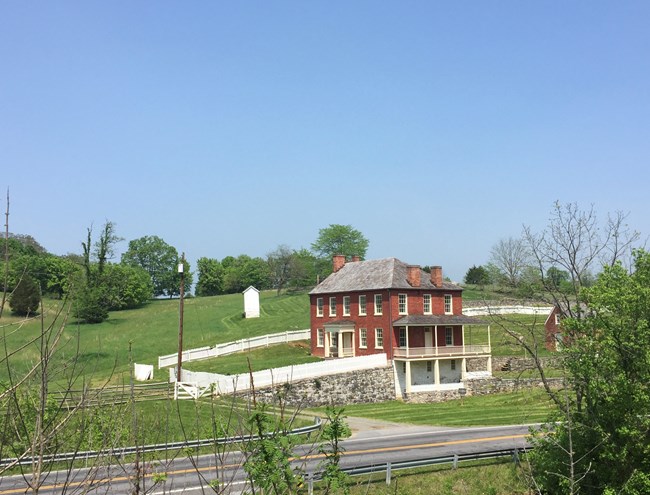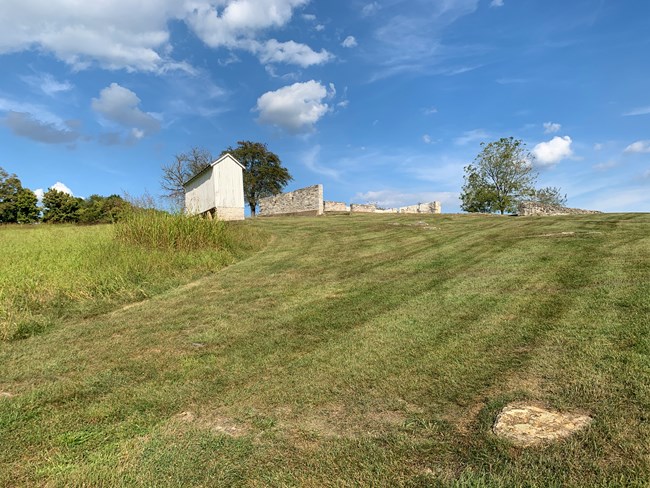
NPS Antietam Establishment of the FarmChristian Orndorff purchased the land that would eventually be known as the Sherrick farm in 1761. Orndorff owned a large tract in the area, and upon his death his son divided the land and sold it to two families who wanted to settle along the Antietam Creek in 1796. Joseph Sherrick and Jacob Mumma made the journey from Lancaster County, Pennsylvania to the outskirts of Sharpsburg. Since their farmsteads adjoined on one side, the two families became neighbors in the rolling hills of western Maryland. After the long journey to their new homes, they established a friendship that would span generations.The 194 acres that Joseph purchased included an established farm. The deed refers to existing houses, outhouses, barns, fields, woods, meadows, and a “water ditch that is made for the use of watering the meadow.” The original house, presumed to be a log or timber framed structure, is no longer standing. Joseph’s son, Joseph Jr., acquired the land from his father and continued to enlarge the farm. Joseph Jr. constructed the brick structure that is known today as the Sherrick farmhouse around the time when he took over the farm from his father. The new home was fashioned in a Greek Revival style, and was completed at one time—it has not been substantially enlarged or modified since its construction. The home is also notable for two other reasons. Instead of having a spring house, the structure is built over the spring the family would have used for fresh water and to keep perishable foods cool longer. In addition, the yard was terraced. The architectural trends of the 1830s are evident throughout the interior, with its highly stylized grandeur. Many of the materials were cheaper and more accessible then they appear. The stairs and baseboard molding in the central hall were marbleized with use of paint on a feather, and the simple pine doors were painted to look like dark walnut. A gold painted pinstripe gave the door the appearance of a having a raised edge as if it included an inset panel. These touches gave the impression that the home was finer and the family more affluent. BattleAfter the Confederate defeat at the Battle of South Mountain, General Robert E. Lee pulled his troops back. Moving west, he decided to make a defensive stand around the town of Sharpsburg. The morning before the battle, Confederate troops from Brigadier General Robert Toombs’ brigade took up positions near the house to help guard against Union troops crossing the Antietam Creek near the Lower Bridge, better known as the Burnside Bridge. On September 17, 1862, Confederate artillery was positioned on the heights overlooking the Sherrick farm, where Antietam National Cemetery is today. Additionally, Brigadier General Robert Toombs sent Confederate skirmishers forward of their line to guard the approach to the Lower Bridge. Their goal was to prevent Union soldiers from using the narrow ravine between the Otto and Sherrick farms to get to the bridge. During the fighting, the Sherrick home was hit at least once by an artillery shell and suffered some damage from rifle fire. However, the home made it out of the fight relatively unharmed. Similarly, the outbuildings on the property also suffered little damage.
NPS Antietam / B.Baracz AftermathWhile the Sherrick home was not badly damaged, combat and hungry soldiers had devastated their fields and food stores. Union forces used the Sherrick farm as a field hospital in the aftermath of the battle. The Union army stayed on the field for roughly six weeks following the battle to tend to the dead and wounded. In addition, the Army of the Potomac needed to resupply and train the many new regiments that had the misfortune to join right before the bloodiest single-day battle. This extended bivouac proved more damaging to the Sherrick’s farm then the battle itself.Historians believe that in the years before the battle, Joseph Sherrick, Jr. retired from farming and was in the process of moving out of his home to a new one about ten miles north in nearby Funkstown, Maryland. As a result, it is likely that Sherrick rented out a tenant house on his farm. His tenant, Leonard Emmert, tended the Sherrick’s fields at the time of the battle. Joseph Sherrick filed claims to the government for $8 of structural damage from artillery shells to his home and $1,351 in damages from occupying Federal troops. However, the Sherrick’s loss was nothing compared to what the family’s neighbors and old friends, the Mummas, suffered. Samuel and Elizabeth Mumma and their ten children lived in a house in the center of the battlefield. The Confederate soldiers burned down the Mumma house to prevent Union sharpshooters from using the upper windows as cover, leaving the family homeless. All that remained of the Mumma farm were three brick walls and the shell of their spring house; all the other outbuildings had burned. Historians believe that the Sherrick’s tenant, Emmert, lived in a separate structure located on the property that is no longer standing. This left the main house empty, and Joseph allowed the Mummas to move in after the battle. They stayed at his home for nine months until they were able to rebuild in June 1863. This act of kindness is a testament to the bonds among this small community and how residents did their best to look after each other in times of hardship. To Present DayAfter the Mummas moved out, Joseph continued to rent the farm to tenants, and sold some portions of his property, possibly to try and recuperate money his family lost during the Maryland Campaign. Joseph Sherrick, Jr. died in 1871, and his wife died in 1874; both are buried in the Mumma Cemetery along with Joseph’s parents and members of the Mumma family, once again showing the close ties of these two families in life and death. Joseph’s son-in-law, Victor Newcomer, inherited the farm and continued to seek compensation from the government, but he received very little. For several decades, the property remained in the Sherrick-Newcomer family. Sections of the land were sold to veterans’ associations for the placement of monuments and to the federal government for preservation. In 1925, after being in the family for 129 years, the home was sold outside of the family to James Doresy. The National Park Service purchased the 186-acre farm in 1964. The home remains largely untouched; the most extensive modification was the addition of electricity in 1958. Several of the original outbuildings no longer exist. For instance, any tenant houses and a stone outbuilding visible in Alexander Gardner’s photographs taken several days after the battle have vanished. Only the foundation of the barn, which predated the battle, still stands. Unfortunately, the barn caught fire on the night of June 18-19, 1985 and was destroyed. Today, visitors can see the Sherrick farm along the driving tour road as they approach Stop 9, the Burnside Bridge. In 1965, a bypass road was created to divert traffic off the Burnside Bridge in order to better preserve this iconic structure. The grounds are accessible by hiking or taking the bypass road, known as Burnside Bridge Road. This splendid Greek Revival home has remined unchanged and enables us to understand the prosperous farming community of Sharpsburg and the Sherrick family. It transports us back in time not only to the Battle of Antietam, but to the height of fashion in the 1830s. 
NPS Antietam / K.Snyder |
Last updated: September 15, 2023
